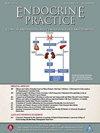Effects of Continuous Glucose Monitoring Versus Blood Glucose Monitoring During a Carbohydrate-Restricted Nutrition Intervention in People With Type 2 Diabetes: 6-Month Follow-up Outcomes From a Randomized Clinical Trial
IF 4.6
3区 医学
Q2 ENDOCRINOLOGY & METABOLISM
引用次数: 0
Abstract
Objectives
Low and very-low carbohydrate eating patterns can improve glycemia in people with type 2 diabetes (T2D). Continuous glucose monitoring (CGM) may also help improve glycemic outcomes, like time in range (TIR). This research evaluated differences in diabetes-related outcomes when people with T2D used CGM or blood glucose monitoring (BGM) to support dietary choices and medication management for 6 months during a virtual, medically supervised ketogenic diet program (MSKDP). Three-month primary outcomes are published, and here we report 6-month follow-up outcomes.
Methods
The IGNITE study (Impact of Glucose moNitoring and nutrItion on Time in rangE) randomized participants to use CGM (N = 81) or BGM (N = 82) to support care during 6 months in a MSKDP. Glycemia, diabetes medications, dietary intake, ketones, and weight were assessed at baseline (Base) and month 6 (M6); differences between and within arms were evaluated.
Results
Adults (N = 163) with mean (SD) T2D duration of 9.7 (7.7) years and HbA1c of 8.1% (1.2%) participated. From Base to M6, TIR improved from 61% to 87% for CGM and from 63% to 88% for BGM (P < .001), with no difference in changes between arms (P = .99). HbA1c decreased at least 1.3% from Base to M6 in both arms (P < .001). Diabetes medications were deintensified in both arms based on medication effect scores (P < .01). Energy and carbohydrate intake decreased (P < .001) and participants in both arms had clinically meaningful weight loss (P < .001).
Conclusions
The CGM and BGM arms achieved similar and significant improvements in glycemia and other diabetes-related outcomes after 6 months in this MSKDP.
2型糖尿病患者在限制碳水化合物营养干预期间连续血糖监测与血糖监测的效果:一项随机临床试验的6个月随访结果
低碳水化合物和极低碳水化合物饮食模式可以改善2型糖尿病(T2D)患者的血糖。连续血糖监测(CGM)也可能有助于改善血糖结局,如范围内时间(TIR)。本研究评估了t2dm患者在虚拟医学监督的生酮饮食计划(MSKDP)中使用CGM或血糖监测(BGM)支持饮食选择和药物管理6个月的糖尿病相关结果的差异。我们公布了三个月的主要结果,并在此报告了六个月的随访结果。方法:IGNITE研究(葡萄糖监测和营养对时间范围的影响)将参与者随机分组,在MSKDP中使用CGM (N=81)或BGM (N=82)来支持六个月的护理。在基线(Base)和第6个月(M6)时评估血糖、糖尿病药物、饮食摄入、酮类和体重;评估两组之间和组内的差异。结果:参与研究的成人(N=163)平均(SD) T2D持续时间为9.7(7.7)年,HbA1c为8.1%(1.2%)。从基础组到M6组,CGM组的TIR提高了61%至87%,BGM组的TIR提高了63%至88%。结论:在该MSKDP治疗6个月后,CGM组和BGM组在血糖和其他糖尿病相关结局方面取得了相似且显著的改善。
本文章由计算机程序翻译,如有差异,请以英文原文为准。
求助全文
约1分钟内获得全文
求助全文
来源期刊

Endocrine Practice
ENDOCRINOLOGY & METABOLISM-
CiteScore
7.60
自引率
2.40%
发文量
546
审稿时长
41 days
期刊介绍:
Endocrine Practice (ISSN: 1530-891X), a peer-reviewed journal published twelve times a year, is the official journal of the American Association of Clinical Endocrinologists (AACE). The primary mission of Endocrine Practice is to enhance the health care of patients with endocrine diseases through continuing education of practicing endocrinologists.
 求助内容:
求助内容: 应助结果提醒方式:
应助结果提醒方式:


